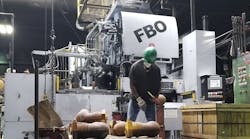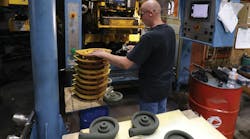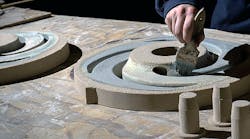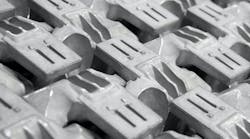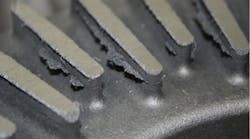Veining (aka, finning) has been a perennial problem for certain types of ferrous castings produced with chemically bonded sand cores. Engine blocks and heads may exhibit veins in narrow oil and water passageways that are difficult to remove, and could cause blockage and engine failure. Ventilated brake rotors may show veining in the “windows” that also are difficult to remove and could cause uneven heating and warpage of the rotor during use. Many different casting types with cored passageways and unfavorable geometries or sand-to-metal ratios can suffer from veining defects.
Veining has long been called an “expansion defect,” linked to the non-linear expansion of silica sand as it is heated by the liquid metal during casting. The sand goes through a change in crystal structure from low or alpha quartz to high or beta quartz that results in rapid expansion, followed by contraction and then further expansion as the quartz transforms to tridamite and then crystoballite. This uneven expansion and contraction is in contrast to the more uniform and lower expansion rates of other foundry aggregates.
There have been a number of different approaches used to combat veining problems. High-purity silica sand can be replaced totally or in part by other aggregates, such as lake or bank sand, zircon, chromite, olivine, fused silica, or man-made materials. The lower and more uniform expansion of these materials can minimize or eliminate veining. However, these materials also are more costly than silica sand and may present special problems with molding or coremaking.
Sand additives have been used extensively to control veining. These fall into several categories depending on their chemistry and activity. Iron oxides were among the first sand additives. They create a small reduction in volume as they lose oxygen and also have a “fluxing” or softening effect on the surface of the sand grains. Red iron oxides (Fe2O3) are typically used at levels of 1-2% but are very fine and may impact mold and core strength. Black iron oxide (Fe3O4) is somewhat coarser and may be used at 1-4% levels. Red iron oxide also has been shown to be effective when used in conjunction with other sand additives. However, iron oxide may have limited compatibility with certain binder systems because of acidity.
Organic materials like dextrin, starch, and wood flour also are used at relatively low levels (0.5-2%.) At elevated temperatures, these will burn out and provide a volume reduction and “cushion.” Like iron oxides, these materials may have negative effects on mold/core strength because the fineness of the material increases resin demand and reduces strength.
Engineered Sand Additives (ESAs) were developed to address some of the negative issues of iron oxides and starches. They may have particles sizes more similar to sand, with less impact on mold/ core strength. However, typically these products must be used at higher levels to be effective against veining. One type of ESA is in the form of hollow spheres. It is believed that these crush and provide a volume reduction and cushion when subjected to compressive stresses. Other ESAs have low-expansion rates and reportedly act as fluxes at elevated temperatures.
Other strategies have been used, too. Coating or “wash” on the mold or core surface can provide some veining resistance with a low-expansion layer and insulating effects that may slow the flow of heat into the surrounding sand. More angular sand can be used to reduce core density and allow space for expansion to occur. Cores can be blown at lower than normal blow pressure to produce cores with intentionally low density to allow for expansion.
Veining Measurement — Two types of test castings typically used to measure the veining characteristics of different sand and binder systems are a step cone and a 2×2 (50 mm×50 mm) penetration casting. The level of veining is determined visually and given a numeric ranking of 1 to 5, with level 1 having virtually no veining and level 5 exhibiting very severe veining. The measurement method is somewhat subjective, but identifying the severity and location of the vein and using a weighted formula to calculate a veining “score” will provide additional quantification. Studies have shown that “the defect analysis technique was demonstrated to be a viable procedure as an evaluation tool in assessing foundry materials to prevent core-related defects.”
The 2×2 casting test provides an advantage in that four separate cores can be tested per casting, although cores are typically tested in duplicate to improve accuracy. It also seems to be somewhat more severe in that veins still appear in the 2×2 when step cone cores of the same composition appear free of defects.
Anti-Veining and Anti-Penetration Additive with Uncoated Cores — There has been a lot of effort in recent years to eliminate the coating process in foundries. In some areas the target has been successfully implemented, e.g. for lower-demand ductile iron castings. ASK Chemicals has developed new additives that allow foundries to reduce casting defects significantly and cast more uncoated cores. Veino Ultra is one additive that has demonstrated significant anti-veining properties.
Antiveining Coating — Special requirements for casting quality call for no veins along the parting line of the core box. There is also demand for cores that have no deformation during drying. Samples produced using ASK Chemicals’ Miratec BD coating development show that it eliminated the veining, and because of the improved application properties the cores can be dipped at reduced cycles, which has been improved 100% with no drop-off in core productivity.
High Gas-Permeable Coatings — Scabs and gas defects are among the most difficult problems for series production because they lead to scrapped products. Working within the framework of a development project, ASK developed several highly gas-permeable coatings that suppress these defects.
Parts with highly thermally loaded cores that are cast with low mold filling in critical areas tend to suffer from scab formation. With Miratec MB 501, a coating that shows good results (especially in the serial casting) for avoiding veining and penetration, “increased gas permeability” was accomplished. By adopting this coating the scab defects were removed for both a hydraulic casting part (coldbox core package, shell sand) and for an axle housing (coldbox core). Furthermore, the cycle time of the dipping process has been cut in half with this coating, compared to the coating used previously.
Residue-Free Castings — OEMs are requiring that foundries supply castings with minimal levels of residue. For motor blocks these limits could be as low as 300 mg per casting. Due to the fact, that the water jackets or oil galleries are almost impossible to shot-blast, there is a critical demand for coatings that provide flawless castings but also zero adherence of the coating to the casting surface.
A special coating with good anti-veining and anti-penetration properties has been developed, one that reduces the coating residue after pouring to a minimum. SEM investigations show that the coating has self-releasing properties after pouring.
The investigation showed that with the Miratec TS the coating flakes off from the casting itself and releases a very clean surface. The residue was reduced to one-half to one-third compared with the conventional coating.
Protection Against Graphite Degeneration in DI and CGI — Coatings have been developed that block the transport of sulfur or oxygen into the melt. Different mechanisms are available to maintain the targeted property. One is to reduce the transport of sulfur or oxygen toward the interface with the metal by applying coatings with impregnating properties, e.g. Silico IM 801. Another mechanism is to use sulfur- or oxygen-adsorbing components, e.g. calcium compounds, in the coating.
New coating and additive developments allow foundries to produce flawless and residue-free castings in a simplified way with fewer side effects, and allow coating-free casting production.
Reinhard Stötzel, Christian Koch, Carlos Luft, and Friedhelm Meyer are affiliated with ASK Chemicals. More information is available at www.ask-chemicals.com


